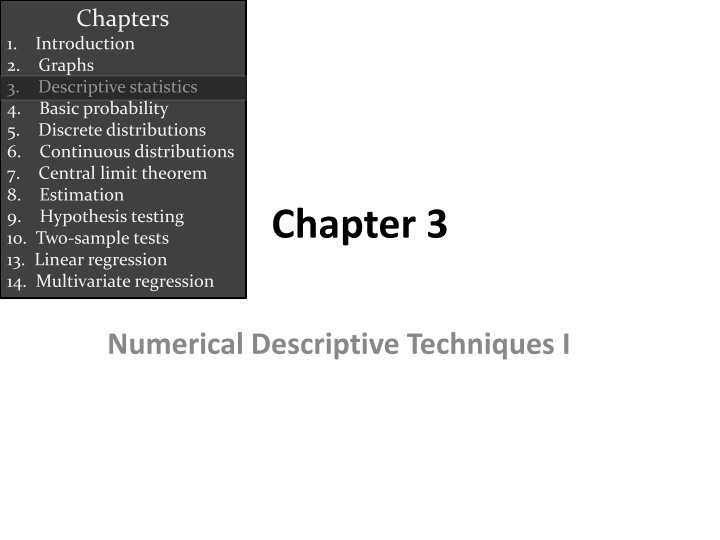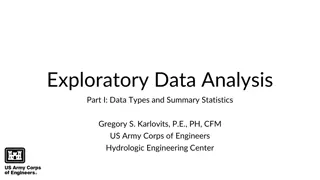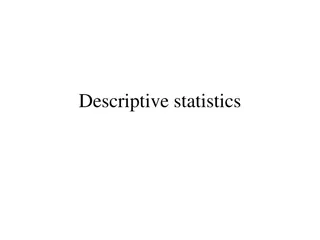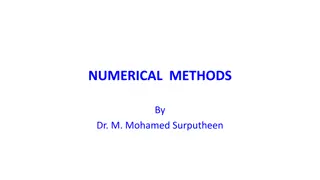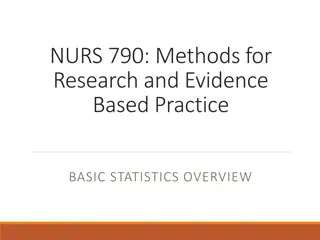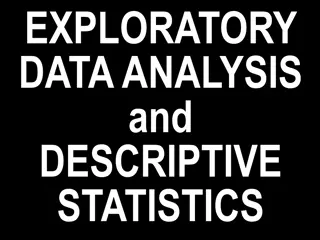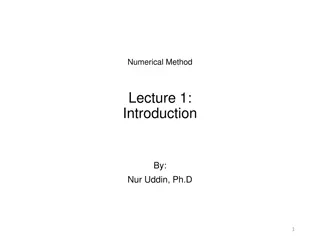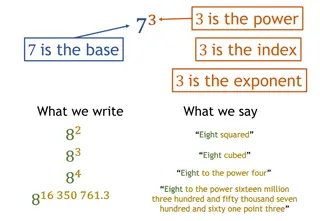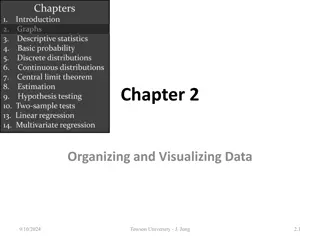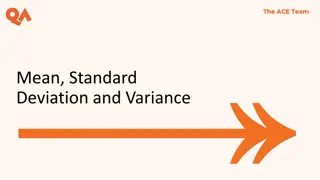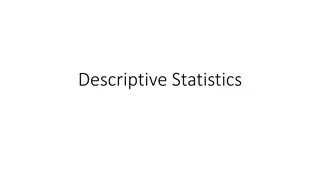Numerical Descriptive Techniques in Statistics
This chapter delves into numerical descriptive techniques in statistics, covering measures of central location like mean, median, and mode, as well as measures of variability like range, standard deviation, variance, and coefficient of variation. It also discusses measures of relative standing, linear relationships, and provides examples illustrating the calculation of these statistical measures.
Download Presentation

Please find below an Image/Link to download the presentation.
The content on the website is provided AS IS for your information and personal use only. It may not be sold, licensed, or shared on other websites without obtaining consent from the author.If you encounter any issues during the download, it is possible that the publisher has removed the file from their server.
You are allowed to download the files provided on this website for personal or commercial use, subject to the condition that they are used lawfully. All files are the property of their respective owners.
The content on the website is provided AS IS for your information and personal use only. It may not be sold, licensed, or shared on other websites without obtaining consent from the author.
E N D
Presentation Transcript
Chapters 1. Introduction 2. Graphs 3. Descriptive statistics 4. Basic probability 5. Discrete distributions 6. Continuous distributions 7. Central limit theorem 8. Estimation 9. Hypothesis testing 10. Two-sample tests 13. Linear regression 14. Multivariate regression Chapter 3 Numerical Descriptive Techniques I
Introduction Recall Lecture 2, where we used graphical techniques to describe data: While this histogram provides some new insight, other interesting questions (e.g. what is the class average? what is the mark spread?) go unanswered. 9/18/2024 Towson University - J. Jung 4.2
Numerical Descriptive Techniques Measures of Central Location/Central Tendency Mean, Median, Mode Measures of Variability/Dispersion Range, Standard Deviation, Variance, Coefficient of Variation Measures of Relative Standing Percentiles, Quartiles Measures of Linear Relationship Covariance, Correlation, Least Squares Line 9/18/2024 Towson University - J. Jung 4.3
Measures of Central Location The arithmetic mean, a.k.a. average, shortened to mean, is the most popular & useful measure of central location. It is computed by simply adding up all the observations and dividing by the total number of observations: Sum of the observations Number of observations Mean = 9/18/2024 Towson University - J. Jung 4.4
Notation When referring to the number of observations in a population, we use uppercase letter N When referring to the number of observations in a sample, we use lower case letter n The arithmetic mean for a population is denoted with Greek letter mu : Parameter or Statistic? The arithmetic mean for a sample is denoted with an x-bar : Parameter or Statistic? 9/18/2024 Towson University - J. Jung 4.5
Statistics is a pattern language Population Sample N n Size Mean 9/18/2024 Towson University - J. Jung 4.6
Median The median is calculated by placing all the observations in order; the observation that falls in the middle is the median. Data: {0, 7, 12, 5, 14, 8, 0, 9, 22} N=9 (odd) Sort them bottom to top, find the middle: 0 0 5 7 8 9 12 14 22 Data: {0, 7, 12, 5, 14, 8, 0, 9, 22, 33} N=10 (even) Sort them bottom to top, the middle is the simple average between 8 & 9: 0 0 5 7 8 9 12 14 22 33 median = (8+9) 2 = 8.5 Sample and population medians are computed the same way. 9/18/2024 Towson University - J. Jung 4.7
Measures of Central Location The mode of a set of observations is the value that occurs most frequently. A set of data may have one mode (or modal class), or two, or more modes. Mode is a useful for all data types, though mainly used for nominal data. For large data sets the modal class is much more relevant than a single-value mode. Sample and population modes are computed the same way. 9/18/2024 Towson University - J. Jung 4.8
Mode E.g. Data: {0, 7, 12, 5, 14, 8, 0, 9, 22, 33} N=10 Which observation appears most often? The mode for this data set is 0. How is this a measure of central location? A modal class Frequency Variable 9/18/2024 Towson University - J. Jung 4.9
Mean, Median, Mode If a distribution is symmetrical, the mean, median and mode may coincide mode median mean 9/18/2024 Towson University - J. Jung 4.10
Mean, Median, Mode If a distribution is asymmetrical, say skewed to the left or to the right, the three measures may differ. E.g.: median mode mean 9/18/2024 Towson University - J. Jung 4.11
For Interval Data If data are symmetric, the mean, median, and mode will be approximately the same. If data are skewed, or have outliers, report the MEDIAN. Mean is very sensitive to extreme values called outliers . If data are multimodal, report the mean, median and/or mode for each subgroup. 9/18/2024 Towson University - J. Jung 4.12
Examples As soon as a billionaire moves into a neighborhood, the average household income increases beyond what it was previously! Imagine if NBA player Yao were in this class, what happens to the mean height and median height of the class. 9/18/2024 Towson University - J. Jung 4.13
Incomes in a Neighborhood X={20,000; 40,000; 60,000; 80,000} Mean = 50,000 Median = 50,000 Now a Millionaire moves into the neighborhood X={20,000; 40,000; 60,000; 80,000;1,000,000} Mean = huge number Median = 60,000 9/18/2024 Towson University - J. Jung 4.14
Mean, Median, Mode: Which Is Best? With three measures from which to choose, which one should we use? The mean is generally our first selection. However, there are several circumstances when the median is better. The mode is seldom the best measure of central location. One advantage the median holds is that it is not as sensitive to extreme values as is the mean. 9/18/2024 Towson University - J. Jung 4.15
Mean, Median, Mode: Which Is Best? To illustrate, consider the data in Example 4.1. The mean was 11.0 and the median was 8.5. Now suppose that the respondent who reported 33 hours actually reported 133 hours (obviously an Internet addict). The mean becomes : n = x i + + + + + + + + 0 7 12 5 133 14 8 0 22 210 = i 1 = = = x 21 0 . n 10 10 9/18/2024 Towson University - J. Jung 4.16
Mean, Median, Mode: Which Is Best? This value is exceeded by only two of the ten observations in the sample, making this statistic a poor measure of central location. The median stays the same. When there is a relatively small number of extreme observations (either very small or very large, but not both), the median usually produces a better measure of the center of the data. 9/18/2024 Towson University - J. Jung 4.17
For Ordinal & Nominal Data For ordinal and nominal data the calculation of the mean is NOT valid. Median is appropriate for ordinal data. For nominal data, a mode calculation is useful for determining highest frequency but not central location . 9/18/2024 Towson University - J. Jung 4.18
Measures of Central Location: Summary Compute the Mean to Describe the central location of a single set of interval data Compute the Median to Describe the central location of a single set of interval or ordinal data Compute the Mode to Describe a single set of nominal data 9/18/2024 Towson University - J. Jung 4.19
? Measure of Central Location PPG 14 12 10 Frequency 8 6 4 2 0 16 18 20 22 24 26 28 Bin 9/18/2024 Towson University - J. Jung 4.20
? Measure of Central Location NBA Player 20 18 16 14 Frequency 12 10 8 6 4 2 0 Forward Guard Center Position 9/18/2024 Towson University - J. Jung 4.21
Weighted Mean Wi=Weight of Observation i. ( ) X W i W i = X WiXi W i Grades (Xi) # of Grades (Wi) A=4 4 4*4=16 B=3 7 7*3=21 C=2 3 3*2=6 D=1 1 1*1=1 = = ( ) 44 15 X i W W i i GPA=44/15=2.93 9/18/2024 Towson University - J. Jung 4.22
Grouped Data Median Class is the class with the n/2 entry Modal Class is the class with the largest frequency. ( ) ( ) M f M f i i i i = = X est f n i Costs $ Frequency fi Mi Mi*fi Cumulative fi (Midpoint) 0-100 100-200 200-300 300-400 400-500 10 18 60 70 42 100/2=50 150 250 350 450 500 2700 15000 24500 18900 10 28 88 158 200 Median Class is 300-400. Modal class is 300-400. = = 61600 200 61600 = = 308 X est 200 9/18/2024 Towson University - J. Jung 4.23
Measures of Variability Measures of central location fail to tell the whole story about the distribution; that is, how much are the observations spread out around the mean value? For example, two sets of class grades are shown. The mean (=50) is the same in each case But, variability are not the same. The red class has greater variability than the blue class. 9/18/2024 Towson University - J. Jung 4.24
Range The range is the simplest measure of variability, calculated as: Range = Largest observation Smallest observation E.g. Data: {4, 4, 4, 4, 50} Data: {4, 8, 15, 24, 39, 50} Range = 46 The range is the same in both cases, but the data sets have very different distributions Range = 46 9/18/2024 Towson University - J. Jung 4.25
Range Its major advantage is the ease with which it can be computed. Its major shortcoming is its failure to provide information on the dispersion of the observations between the two end points. Moreover, range is sensitive to extreme values, just like the mean. Inter Quartile Range (IQR) is one common solution. Hence we need a measure of variability that incorporates all the data and not just two observations. Hence 9/18/2024 Towson University - J. Jung 4.26
Variance Variance and its related measure, standard deviation, are arguably the most important statistics. Used to measure variability, they also play a vital role in almost all statistical inference procedures. Population variance is denoted by (Lower case Greek letter sigma squared) Sample variance is denoted by (Lower case S squared) 9/18/2024 Towson University - J. Jung 4.27
Variance The difference between one obs. and the mean is called Deviationof the obs. The variance of a population is: population mean sample mean population size The variance of a sample is: Note! the denominator is sample size (n) minus one ! 9/18/2024 Towson University - J. Jung 4.28
Variance As you can see, you have to calculate the sample mean (x-bar) in order to calculate the sample variance. Alternatively, there is a short-cut formulation to calculate sample variance directly from the data without the intermediate step of calculating the mean. Its given by: 9/18/2024 Towson University - J. Jung 4.29
Variance Why is sample variance different from population variance? A sample does not include all the information of a population. Samples tend to UNDER estimate the population variability. If we divide by (n-1) instead of n, we get a slightly larger number. (n-1) is called the degree of freedom of the sample. 9/18/2024 Towson University - J. Jung 4.30
Application Example 4.7. The following sample consists of the number of jobs six students applied for: 17, 15, 23, 7, 9, 13. Finds its mean and variance. What are we looking to calculate? The following sample consists of the number of jobs six students applied for: 17, 15, 23, 7, 9, 13. Finds its mean and variance. as opposed to or 2 9/18/2024 Towson University - J. Jung 4.31
Sample Mean & Variance Sample Mean Sample Variance Sample Variance (shortcut method) 9/18/2024 Towson University - J. Jung 4.32
Standard Deviation The standard deviation is simply the square root of the variance, thus: Population standard deviation: Sample standard deviation: 9/18/2024 Towson University - J. Jung 4.33
Standard Deviation It is not easier to calculate you have to get a variance first. It is easier to interpret than variance. It is measured in the same unit as the data is measured. 9/18/2024 Towson University - J. Jung 4.34
Standard Deviation Consider Example 4.8 where a golf club manufacturer has designed a new club and wants to determine if it is hit more consistently (i.e. with less variability) than with an old club. Using Tools > Data Analysis > Descriptive Statistics in Excel, we produce the following tables for interpretation You get more consistent distance with the new club. 9/18/2024 Towson University - J. Jung 4.35
